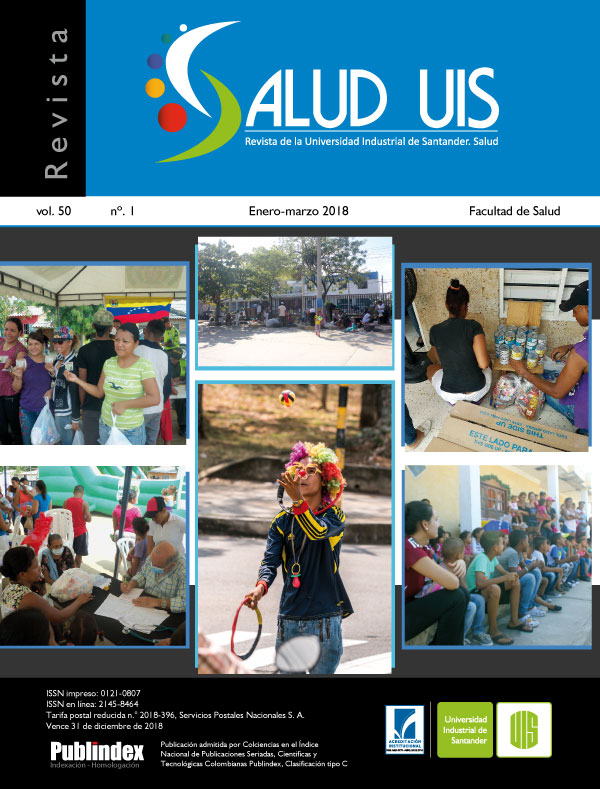Abstract
Introduction: Hemophilia is the most common congenital hemorrhagic disorder in males. Patients with severe disease may have spontaneous bleeding leading to disability. Objective: To describe the bleedings and clinical features of children diagnosed with hemophilia and treated in a reference center in Bogotá. Methodology:Descriptive study of a case series of children (under 18 years) diagnosed with hemophilia, between May 1st and December 31th 2014. Results: Fifty-one patients were included, 33/51 experienced 109 bleedings. Most common type were hemarthrosis and children with inhibitory antibodies had more bleeding episodes. Twenty-two patients had severe hemophilia, 18 moderate and 11 mild. In 18 of 22 severe patients, there were 87 bleeding episodes. 14/33 patients with arthropathy (77%) experienced 74 bleeding events while the rest referred only 35. Patients between 5 to 9 years old had the highest frequency of bleeding. Among the 81 traumatic episodes, most frequent activities were playing and sport practicing; there were 19 spontaneous bleedings and nine were related to procedures. 89 bleeds occurred during school days and 25 on vacation. At the time of bleeding, in 76 episodes, patients were accompanied by family members. Conclusions: Bleeding was more frequent in children with severe disease, with arthropathy, during school time and while being accompanied. Bleedings did not occurred with a higher frequency in children with family dysfunction.
References
2. Konkle BA, Huston H, Nakaya SF. Hemophilia A. En: Adam MP, Ardinger HH, Pagon RA, Wallace SE. GeneReviews. last revision: June 22, 2017. Seattle: University of Washington, Seattle; 1993-2017.
3. Srivastava A, Brewer AK, Mauser-Bunschoten EP, Key NS, Kitchen S, Llinas A, et al; Treatment guidelines working group on behalf of the world federation of hemophilia. Guidelines for the management of hemophilia. Haemophilia. 2013; p. 1-47.
4. Gringeri A, Lundin B, Von Mackensen S, Mantovani L, Mannucci pm, and The ESPRIT Study Group. A randomized clinical trial of prophylaxis in children with hemophilia A (the ESPRIT Study). J Thromb Haemost. 2011; 9(4): 700-710. DOI: 10.1111/j.1538-7836.2011.04214.x.
5. Acharya SS. Advances in hemophilia and the role of current and emerging prophylaxis. Am J Manag Care. 2016; 22(5 Suppl): 116-125.
6. Valentino LA, Mamonov V, Hellmann A, Quon DV, Chybicka A, Schroth P, et al. A randomized comparison of two prophylaxis regimens and a paired comparison of on-demand and prophylaxis treatments in hemophilia A management. J Thromb Haemost. 2012; 10(3): 359-367. DOI: 10.1111/j.1538-7836.2011.04611.x.
7. Manco-Johnson MJ, Abshire TC, Shapiro AD, Riske B, Hacker MR, Kilcoyne R, et al. Prophylaxis versus episodic treatment to prevent joint disease in boys with severe hemophilia. N Engl J Med. 2007; 357(6): 535-544.
8. Zhao Y, Xiao J, Yang R, Wu R, Hu Y, Beckmann H, et al. Efficacy of standard prophylaxis versus on-demand treatment with bayer´s sucroseformulated recombinant FVIII (rFVIII-FS) in chinese children with severe hemophilia A. Pediatr Hematol Oncol. 2017; 34(3): 138-148. DOI: 10.1080/08880018.2017.1313921.
9. Bertamino M, Riccardi M, Banov L, Svahn J, Molinari JC. Hemophilia care in the pediatric age. J. Clin. Med. 2017; 6(5): PiiE54. DOI:10.3390/jcm6050054.
10. Rodríguez-Merchán EC. Articular bleeding in hemophilia. Cardiovasc Hematol Disord Drug Targets. 2016; 16(1): 21-24.
11. Melchiorre D, Manetti M, Matucci-Cerinic M. Pathophysiology of hemophilic arthropathy. J Clin Med. 2017; 25: 6(7). pii: E63. DOI: 10.3390/jcm6070063
12. Bellón JA, Delgado A, Luna JD, Lardelli P. Validity and reliability of the family Apgar family function test. Aten Primaria. 1996; 18(6): 289-295.
13. Fischer K, Collins P, Bjorkman S, Blanchette V, Oh M, Fritsch S, et al. Trends in bleeding patterns during prophylaxis for severe haemophilia: observations from a series of prospective clinical trials. Haemophilia. 2011; 17(3): 433-438. DOI: 10.1111/j.1365-2516.2010.02450.x.
14. Morfini M, Haya S, Tagariello G, Pollman H, Quintana M, Siegmund B, et al. European Study on Orthopaedic Status of hemophilia patients with inhibitors. Haemophilia. 2007; 13: 606-612.
15. Dekoven M, Karkare S, Lee WC, Kelley LA, Cooper Dl, Pham H, et al. Impact of haemophilia with inhibitors on caregiver burden in the United States. Haemophilia. 2014; 20(6): 822-830. DOI: 10.1111/hae.12501.
16. Valentino LA. Assessing the benefits of FEIBA prophylaxis in haemophilia patients with inhibitors. Haemophilia. 2010; 16(2): 263-271. DOI: 10.1111/j.1365-2516.2009.02126.x.
17. Lentz SR, Cerqueira M, Janic D, Kempton C, Matytsina I, Misgav M, et al. Interim results from a large multinational extension trial (guardianTM2) using turoctocog alfa for prophylaxis and treatment of bleeding in patients with severe haemophilia A. Haemophilia. 2016; 22(5): e445-449. DOI: 10.1111/hae.12990.
18. Ozelo M, Villaca PR, Perez-Bianco R, Candela M, Garcia-chavez J, Moreno-Roodrigez B, Rodriguez MB, et al. Musculoskeletal evaluation in severe haemophilia A patients from Latinamerica. Haemophilia. 2014; 20(1): e63–e70. DOI: 10.1111/hae.12316.
19. Fischer K, Astermark J, Van Der Bom G, Ljung R, Berntorp E, Grobbee DE, Van Den Berg HM. Prophylactic treatment for severe haemophilia: comparison of an intermediate-dose to a high-dose regimen. Haemophilia. 2002; 8(6): 753-760.
20. Hofstede Fg, Fijnvandraat K, Plug I, Kamphuisen P. W, Rosendaal Fr, Peters M. Obesity: a new disaster for haemophilic patients?A nationwide survey. Haemophilia. 2008;14:1035-1038.
21. Ullman M, Zhang QC, Brown D, Grant A, Soucie JM. Haemophilia treatment center network Investigators. Association of overweight and obesity with the use of self and home-based infusion therapy among haemophilic men. Hemophilia. 2014; 20(3): 340-348. DOI: 10.1111/hae.12303.
22. Kulkarni R, Karim FA, Glamocanin S, Janic D, Vdovin V, Ozelo M, et al. Results from a large multinational cinical trial (guardian 3) using prophylactic treatment with turoctocog alfa in paediatric patients with severe haemophilia: safety, efficacy and pharmacokinetics. Haemophilia. 2013; 19(5): 698-705. DOI: 10.1111/hae.12165.
Se autoriza la reproducción total o parcial de la obra para fines educativos, siempre y cuando se cite la fuente.
Esta obra está bajo una Licencia Creative Commons Atribución 4.0 Pública Internacional.
